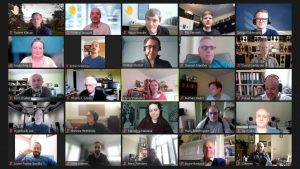For this month’s AES South German Section Research Colloquium, two experts in the field of audio measurements and pychoacoustic perception discussed their experiences regarding commonly used methods of listening tests, their evaluation and the analysis of measurements, with full interaction with the audience.
Dr Hyunkook Lee – Discrimination between Audio Stimuli: How to Design an ABX Test

Dr Hyunkook Lee talked about currently used listening test procedures that can be used for signal detection or discrimination testing. He focused on the ABX test, which is designed to identify a stimulus X that is equivalent to one of the stimuli A or B. Using examples of real tests, he demonstrated psychophysical and random-switched designs for ABX tests including the parameters that should be considered in the analysis process to evaluate the results and to identify possible biases, all based on signal detection theories. He concluded by addressing where an ABX test is appropriate, defining limitations and suggesting alternative test methods.
We thank Dr Hyunkook Lee for a well understandable presentation of this complex topic. He opened different perspectives to design a listing test for a particular task and analyse its results.
A video of the presentation is available on Youtube.
Additional Information
Philipp Strobel – Headphone Measurements vs. Listening Tests: Are We Missing Something?
Philipp Strobel’s field of work focuses mainly on the binaural synthesis of headphones to reduce the flaws of loudspeakers and room acoustics in the listening experience. Therefore, he wanted to investigate whether new technologies improve sound reproduction, focusing on macro- and micro-dynamics. Starting with a listening test comparing different products in different price ranges, he carried out a more detailed comparison of two open headphones and presented the test framework, the signal processing techniques used and the parameters in time and frequency that influence psychoacoustic perception. Even with matching parameters, there was an audible difference. This leads to the questions: “What is missing here?” and “How can the differences be quantified?”
We thank Philipp Strobel for the very impressive talk, which highlighted a topic that touches almost everyone working in audio – How to quantify or evaluate the psychoacoustic perception?
A video of the presentation is available on YouTube.
